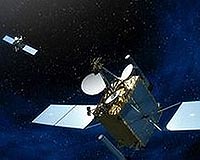 |
Dulles VA (SPX) Jul 02, 2010 Orbital Sciences has announced it has received two separate orders from NASA to launch scientific satellites on its industry-leading small rockets, Pegasus XL and Taurus XL. These contracts bring the total Pegasus and Taurus orders to 55 vehicles since the first Pegasus was purchased in 1988. Taken together, the two rockets have launched or will boost a total of 35 NASA scientific and technology demonstration spacecraft on 30 missions since 1990. Orbital is scheduled to launch the Interface Region Imaging Spectrograph (IRIS) spacecraft in December 2012 aboard a Pegasus XL rocket from Vandenberg Air Force Base in California. IRIS is a NASA Small Explorer (SMEX) mission to measure the Sun's flow of energy through the dynamic region in the solar corona and heliosphere to help scientists better understand the effects of solar energy release processes on Earth. The planned 2012 launch will be the rocket's 45th mission since its initial flight in 1990 and the second Pegasus launch scheduled for that year, following the launch of the Orbital-built NuSTAR scientific satellite in February 2012. In a separate contract, NASA tapped the company's Taurus XL launch vehicle to boost the Orbital-built OCO-2 environmental monitoring satellite into orbit. OCO-2 will provide critical space-based data on carbon dioxide in the Earth's atmosphere. A Taurus XL rocket, also launched from Vandenberg, will deliver the OCO-2 satellite into a 705 km sun-synchronous polar orbit where it will join NASA's "A Train" constellation of Earth monitoring scientific satellites. The launch, currently scheduled for early 2013, will represent the 10th flight of a Taurus rocket since its first launch in 1994. The next scheduled Taurus launch will boost the Orbital-built Glory satellite into low-Earth orbit for NASA in the fourth quarter of 2010. "Pegasus and Taurus have been the workhorses of the small launch market for reliable missions to orbit for two decades. With these two new missions, plus those already on the manifest, we expect that will continue to be the case for years to come," said Mr. Ron Grabe, Orbital's Executive Vice President and General Manager of the Launch Systems Group. "With NASA's planned budget increases for small and mid-class science satellites, which deliver high value and are well suited to fast development cycles, Orbital is prepared to support NASA with both spacecraft and the rockets that launch them into orbit to help provide the global science community with important data about the world in which we live."
Share This Article With Planet Earth
Related Links Orbital Launch Pad at Space-Travel.com
 Six Astrium Satellites Launched In A Month
Six Astrium Satellites Launched In A MonthKourou, French Guiana (SPX) Jun 28, 2010 Following the second successful Ariane 5 launch this year - six satellites built by Astrium have now been launched within a month: COMSATBw-2 and ASTRA 3B on 21 May, Arabsat 5B by a Proton launcher on 4 June, TanDEM-X by Dnepr on 21 June and now Arabsat 5A and COMS by Ariane 5 tonight. The six satellites include three commercial communications satellites (Arabsat 5A and 5B, and ASTRA 3B), ... read more |
|
| The content herein, unless otherwise known to be public domain, are Copyright 1995-2010 - SpaceDaily. AFP and UPI Wire Stories are copyright Agence France-Presse and United Press International. ESA Portal Reports are copyright European Space Agency. All NASA sourced material is public domain. Additional copyrights may apply in whole or part to other bona fide parties. Advertising does not imply endorsement,agreement or approval of any opinions, statements or information provided by SpaceDaily on any Web page published or hosted by SpaceDaily. Privacy Statement |